Solving Knapsack problem using Dynamic Programming
Now your job is to select only those books and articles, whose total capacity is less than or equal to that of Knapsack so that you get maximum valuable books and articles inside your knapsack. In this case, the weight of item can be taken as real weight of the books and articles and value of the item can be taken as how important those articles and books for you. And also the Knapsack can support only fix weight items. This is the theoretical explanation, mathematically the problem can be defined as follows
\[ \text {maximize} \sum_{i \in 1 … j} v_ix_i \\
\text {subject to} \sum_{i \in 1 … j}w_ix_i \le k,\;x_i \in \{0,1\}, \; i \in \{1…j\} \]
Where $v_i$ is value of item $i$, $j$ is total number of items, $x_i$ is binary number indicating whether you take item $i$ or not. If you take item $i$ then value of $x_i$ will be 1 otherwise 0. $w_i$ is the weight of item $i$ and $k$ is the capacity of Knapsack. So far I gave you the theoretical and mathematical background of the problem, now I talk about programming model. To illustrate this, here is an example
2 16
3 19
4 23
5 28
Total number of item = 4
Capacity of Knapsack = 7
Here in this example we have total 4 items with different weights and values. The total value of the Knapsack is 7 so the total weight of the items must be less than or equal to 7. Mathematically this can be written as
\[ \text {maximize} 16x_1 + 19x_2 + 23x_3 + 28x_4 \\
\text {subject to} 2x_1 + 3x_2 + 4x_3 + 5x_4 \le 7 \\
x_i \in \{0,1\}, \; i \in \{0…4\} \]
In bottom-up approach what we do is we compute the recursive equations bottom up. i.e. we start with zero items and find out what is the best we can do when we have 0 items to work with. And we take 1 item and find out what is the best we can do when we have 1 item to work with. We perform this up to j items which are 4 in our case. We create a big table with capacity along one side(row) and items on another side (column) and fill that table step by step. First, we take 0 items and try to optimize the Knapsack of size 0, then we take again 0 items and try to optimize for size 1. We perform this up to the total capacity of Knapsack which 7 in our case. We will have capacity +1 rows in the table. Similarly, we take 1 item and try to optimize the Knapsack of size 0 to capacity and so on up to a total number of items. This makes total no of times + 1 columns in the table. Now we have the table with size (capacity +1) along rows and (no of items + 1) along column. In our example, this is 8 x 5. This may look like this
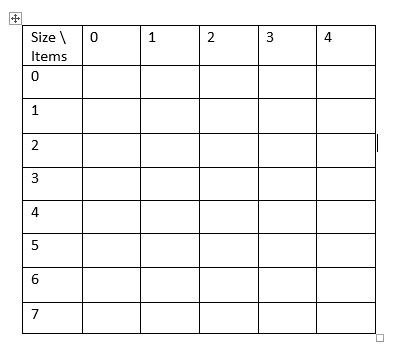
First, we take 0 item. Since there is no item we cannot do any optimization. So the best optimization we get will be

Second, we take 1 item with weight = 2 and value = 16. Since the weight is 2 we need Knapsack with size at least 2. We cannot keep the item with Knapsack of size 0 and 1. So after taking one item, the table will look like.
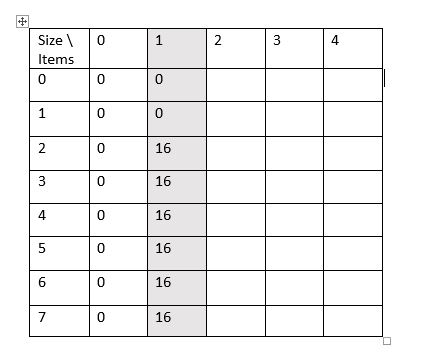
Third, we take two items. The first item is one of given above and the next items are of size = 3 and value = 19. To keep this item we need Knapsack of size at least 3. Since total size of these two items is 5 the Knapsack of size at least 5 can hold both items. So the table for 2 items look like.
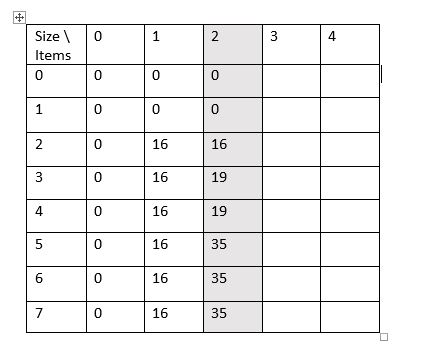
Similarly for 3 items.
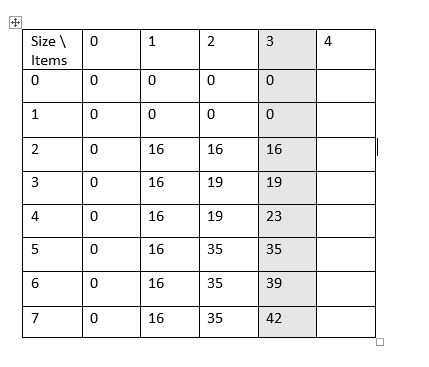
and last for all 4 items
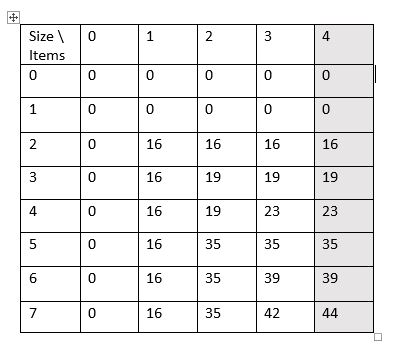
So the best optimization value is 44. Python Script for bottom-up dynamic programming is given below
bestvalues = [[0] * (capacity + 1) for i in range(1,2)]
for i in range(1,itmes+1):
for j in range(1,capacity+1):
if weights[i-1] > j:
bestvalues[i][j] = bestvalues[i-1][j]
else:
candidate1 = bestvalues[i-1][j]
candidate2 = bestvalues[i-1][j-weights[i-1]] + values[i-1]
bestvalues[i][j] = max(candidate1,candidate2)
This only gives the best values. But to determine which items are actually taken to make this optimized value we must backtrack the table. This can be done using following python script
reconstruction = []
i = items
j = capacity
while i > 0:
if bestvalues[i][j] != bestvalues[i - 1][j]:
reconstruction.append(1)
j -= weights[i-1]
else:
reconstruction.append(0)
i -= 1


This article has helped me to understand original article from wikipedia.org. I am saying this as a programmer with over 8 years of coding in various languages. Thanks for the python`s sample of code. Helped a lot
22 g aa galbaat ki a…….